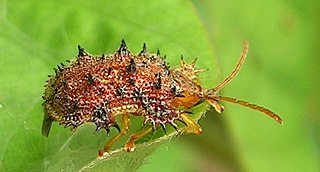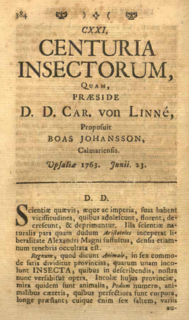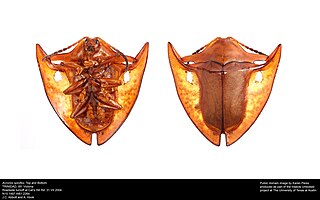
The insects of the beetle family Chrysomelidae are commonly known as leaf beetles, and include over 37,000 species in more than 2,500 genera, making up one of the largest and most commonly encountered of all beetle families. Numerous subfamilies are recognized, but the precise taxonomy and systematics are likely to change with ongoing research.

Bitis inornata is a venomous viper species found only in Cape Province, South Africa. No subspecies are currently recognized.

The Eumolpinae are a subfamily of the leaf beetles, or Chrysomelidae. It is one of the largest subfamilies of leaf beetles, including more than 500 genera and 7000 species. They are oval, and convex in form, and measure up to 10 mm in size. Typical coloration for this subfamily of beetles ranges from bright yellow to dark red. Many species are iridescent or brilliantly metallic blue or green in appearance.

The Cassidinae are a subfamily of the leaf beetles, or Chrysomelidae. The antennae arise close to each other and some members have the pronotal and elytral edges extended to the side and covering the legs so as to give them the common name of tortoise beetles. Some members, such as in the tribe Hispini, are notable for the spiny outgrowths to the pronotum and elytra.

Cassida is a large Old World genus of tortoise beetles in the subfamily Cassidinae. Several species of Cassida are important agricultural pests, in particular C. vittata and C. nebulosa on sugar beet and spinach. The thistle tortoise beetle has been used as a biological control agent against Canada thistle.

Centuria Insectorum is a 1763 taxonomic work by Carl Linnaeus, and defended as a thesis by Boas Johansson; which of the two men should be credited with its authorship has been the subject of some controversy. It includes descriptions of 102 new insect and crustacean species that had been sent to Linnaeus from British America, Suriname, Java and other locations. Most of the new names included in Centuria Insectorum are still in use, although a few have been sunk into synonymy, and one was the result of a hoax: a common brimstone butterfly with spots painted on was described as the new "species" Papilio ecclipsis.

Acromis spinifex is a species of tortoise beetle from South America. The males have enlarged elytra which are probably used in male–male combat, while females are among the few tortoise beetles to show maternal care of their offspring.
Omocerus bicornis is a species of tortoise beetle from South America. It lives on Cordia (Boraginaceae) plants, and is found in Brazil, Surinam, French Guiana, Suriname and Venezuela. It was first described by Carl Linnaeus in his 1763 work Centuria Insectorum under the name Cassida bicornis, and was later made the type species of the genus Omocerus by Philogène Auguste Joseph Duponchel and Alcide d'Orbigny in 1843.

Hemisphaerota is a genus in the subfamily Cassidinae in the family Chrysomelidae. There are about 10 described species in Hemisphaerota.
Shinsaku Kimoto was a Japanese entomologist specialising in the Leaf beetle family (Chrysomelidae).
Cubispa is a genus of leaf beetles consisting of two species from Central America and the Caribbean. It is classified within the tribe Cubispini, which is placed within either the Eumolpinae or the Cassidinae. Beetles in the genus are wingless, and are associated with cloud forests.

Alurnus is a genus of beetles in the family Chrysomelidae.
Calyptocephala attenuata is a species of tortoise beetles in the genus Calyptocephala.
Aspidimorpha dorsata, is a species of leaf beetle widely distributed in South Asia and South East Asia.
Aspidimorpha dorsata, commonly known as golden tortoise beetle or furcated tortoise beetle, is a species of leaf beetle widely distributed in Oriental region from Sri Lanka to South China towards Java, and Borneo.
Cassida (Crepidaspis) cognobilis, is a species of leaf beetle found in India, Sri Lanka, Laos and Thailand.
Cassida obtusata, is a species of leaf beetle widespread in Oriental region from Sri Lanka to China towards Sumatra and the Philippines.
Laccoptera (Laccopteroidea) quatuordecimnotata, is a species of leaf beetle native to India, and Sri Lanka.
Notosacantha vicaria, is a species of leaf beetle native to India, and Sri Lanka.
Chiridopsis marginata, is a species of leaf beetle found in India, and Sri Lanka.








